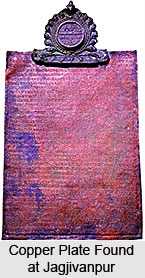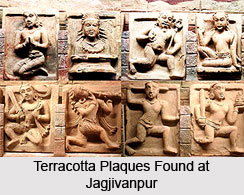 Jagjivanpur, situated in Malda district of West Bengal, is a significant archaeological site which has furnished a copper-plate inscription of Mahendrapaladeva, a Pala emperor, who was unknown to the India history till this discovery. It was found by a chance discovery which was later followed by excavations by a team of the Directorate of Archaeology and Museums, West Bengal Government in 1992. Several mounds have been found at the site among which the most important one is Tulabhita or Salaidanga, having a height of 5 metres. Other mounds which constitute this site are known as Nandagarh, Rajar Mayer Dhipi, Nimdanga and Akhridanga. Structural remains of Stupas, Viharas and other antiquities have also been found here.
Jagjivanpur, situated in Malda district of West Bengal, is a significant archaeological site which has furnished a copper-plate inscription of Mahendrapaladeva, a Pala emperor, who was unknown to the India history till this discovery. It was found by a chance discovery which was later followed by excavations by a team of the Directorate of Archaeology and Museums, West Bengal Government in 1992. Several mounds have been found at the site among which the most important one is Tulabhita or Salaidanga, having a height of 5 metres. Other mounds which constitute this site are known as Nandagarh, Rajar Mayer Dhipi, Nimdanga and Akhridanga. Structural remains of Stupas, Viharas and other antiquities have also been found here.
Copper Plate Found at Jagjivanpur
The copper plate inscription recovered at Jagjivanpur has been found to contain Siddhamatrika script which was highly used in Sanskrit language during 9th century. At the top of the plate, a royal seal has been found attached which consists of a `dharmachakra` at centre with deer on its either side, a lotus and the legend Shri Mahendrapaladeva. Weighing 11.85 kilogram, the plate was issued by King Mahendrapaladeva during the seventh year of his reign on the 2nd day of Vaisakha month. According to the inscription, Mahendrapaladeva was the son of Devapala.
 He had made an announcement on the occasion of a land grant ceremony before his officers and other people that his General had intended to donate the land besides the Nandadirghika Udranga Mahavihara. Nandadirghika Udranga Mahavihara was constructed by the emperor for the worship of Buddhist deities and performing religious rituals.
He had made an announcement on the occasion of a land grant ceremony before his officers and other people that his General had intended to donate the land besides the Nandadirghika Udranga Mahavihara. Nandadirghika Udranga Mahavihara was constructed by the emperor for the worship of Buddhist deities and performing religious rituals.
Other Artefacts Found at Jagjivanpur
Apart form this, circular terracotta seals have also been discovered with inscribed legends. Most of them were monastic however some of them were votive or personal. The most important among them was the monastic seal with depictions of `dharmachakra` and deer motif along with the name of a Vihara. Siddhamatrika inscriptions have been found on the seal. Excavations of collapsed debris of a Stupa complex have revealed over 250 terracotta plaques. The plaques were usually of rectangular shape and red colour composed of fine clay. Evidences suggest that the plaques were probably the embellishments of the outer structure of the Stupa. Various images can be seen on the plaques such as Avalokitesvara, Surya, Shiva, Garuda, Kinnaris, peacock, deer, warriors and many more. Titled bricks with beautiful adornments have also been recovered from Jagjivanpur. They have depictions of various motifs including lotus petal, diamond shaped and others. Excavations have also revealed beads of semi-precious stones, iron or terracotta bangles, terracotta lamps and red and grey potsherds.



















